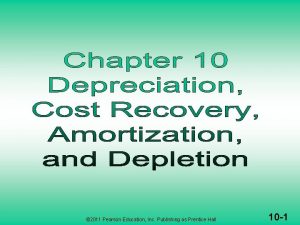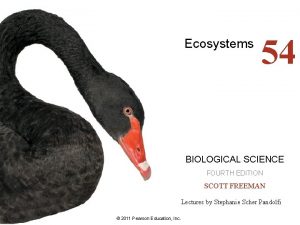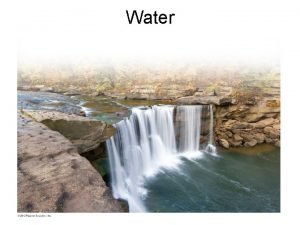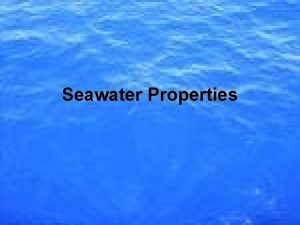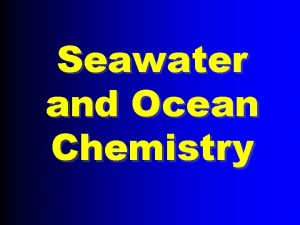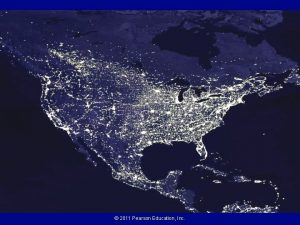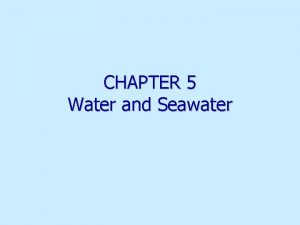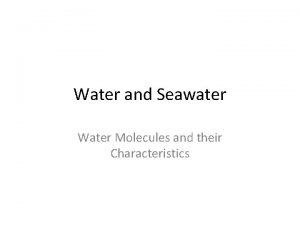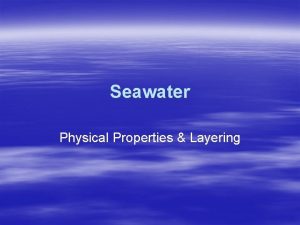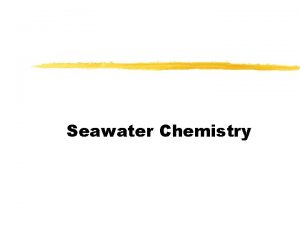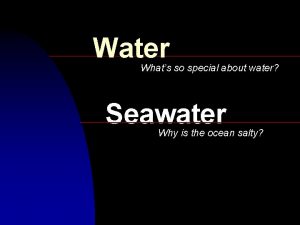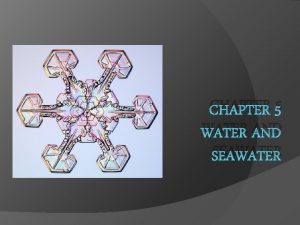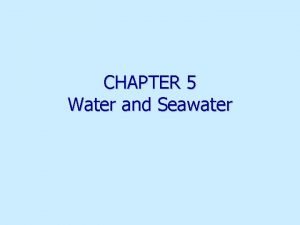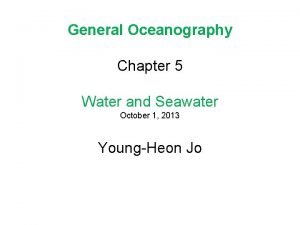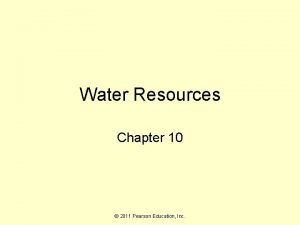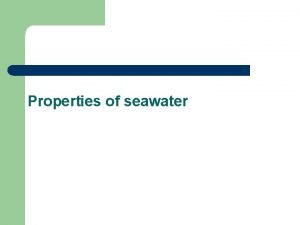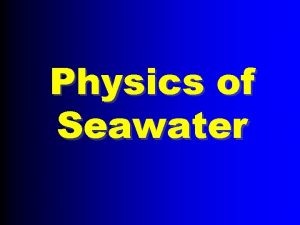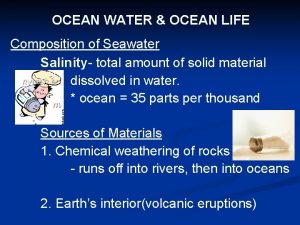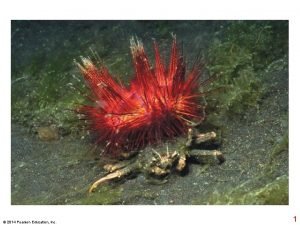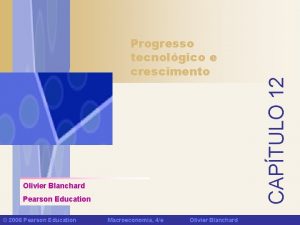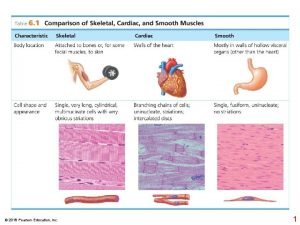CHAPTER 5 Water and Seawater 2011 Pearson Education
























- Slides: 24

CHAPTER 5 Water and Seawater © 2011 Pearson Education, Inc.

Earth’s Water • • • 97. 2% in the world ocean 2. 15% frozen in glaciers and ice caps 0. 62% in groundwater and soil moisture 0. 02% in streams and lakes 0. 001% as water vapor in the atmosphere © 2011 Pearson Education, Inc.

Seawater Components • Water • Dissolved material • Suspended (sediment) material © 2011 Pearson Education, Inc.

The Water Molecule • Polar material • Hydrogen Bonds © 2011 Pearson Education, Inc.

Polar Material • Loves other polar molecules. • What happens when all + and – are taken? ? © 2011 Pearson Education, Inc.

Hydrogen Bonding • Hydrogen bonds (between water) and polarity result in unique properties • See Coursenotes…… © 2011 Pearson Education, Inc.

p. H – Fresh water is 7 (Neutral) – Seawater is around 8 (Slightly Basic) – Buffered……it changes little © 2011 Pearson Education, Inc.

Freezing and Boiling Points • Freezing point = melting point: 32°F • Boiling point = condensation point: 212°F © 2011 Pearson Education, Inc.

Water’s Three States of Matter © 2011 Pearson Education, Inc.

Latent Heat • High latent heats: energy released from – Condensation – Freezing © 2011 Pearson Education, Inc.

Water’s Heat Capacity • High heat capacity • Can take in or lose much heat without changing temperature © 2011 Pearson Education, Inc.

Sea and Land Breezes • Differential heat capacities of land water. • Summer day – From ocean to land • Winter Day – From land to ocean © 2011 Pearson Education, Inc.

Water In The Ocean • Moderates temperatures on Earth • Moderates temperatures in the Ocean © 2011 Pearson Education, Inc.

Salinity • Dissolved solids/Water • Expressed in parts per thousand (ppt) • Typical ocean salinity is 35 ppt (o/oo) (33 -37 o/oo) © 2011 Pearson Education, Inc.

Earth’s Hydrologic Cycle © 2011 Pearson Education, Inc.

Processes Affecting Salinity All Occur on Surface!!! © 2011 Pearson Education, Inc.

Surface Salinity Variation by Latitude © 2011 Pearson Education, Inc.

Global Salinity © 2011 Pearson Education, Inc.

Salinity Variation with Depth • Low latitudes – salinity decreases with depth • High latitudes – salinity increases with depth • Deep ocean salinity fairly consistent globally • Halocline – change in salinity © 2011 Pearson Education, Inc.

Seawater Density • Freshwater density = 1. 000 g/cm 3 • Ocean surface water =1. 022 to 1. 030 g/cm 3 • Ocean layered according to density © 2011 Pearson Education, Inc.

Seawater Density • Density increases with decreasing temperature • Density increases with increasing salinity © 2011 Pearson Education, Inc.

Temperature/Density Variation With Depth • Pycnocline – abrupt change of density with depth • Thermocline – abrupt change of temperature with depth © 2011 Pearson Education, Inc.

Layered Ocean Three distinct water masses based on density: • Mixed surface layer – above thermocline • Upper water – thermocline and pycnocline • Deep water – below thermocline to ocean floor • High latitude oceans – thermocline and pycnocline rarely develop © 2011 Pearson Education, Inc.

Thermocline Curves Deepwater is Always Cold Surfacewater is Polar: Cold Tropical: Warm Temperate: Both!!!! Warm Summer, Cold Winter © 2011 Pearson Education, Inc.
 Water and water and water water
Water and water and water water Pearson education 2011
Pearson education 2011 2011 pearson education inc
2011 pearson education inc 2011 pearson education inc
2011 pearson education inc 2011 pearson education inc
2011 pearson education inc Friedman rank test
Friedman rank test 2011 pearson education inc
2011 pearson education inc 2011 pearson education inc
2011 pearson education inc Prentice hall publishing
Prentice hall publishing 2011 pearson education inc
2011 pearson education inc 2011 pearson education inc
2011 pearson education inc Pearson education 2011
Pearson education 2011 2011 pearson education inc
2011 pearson education inc Pearson education inc. publishing as prentice hall
Pearson education inc. publishing as prentice hall Pearson education 2011
Pearson education 2011 2011 pearson education inc biology
2011 pearson education inc biology 2011 pearson education inc
2011 pearson education inc Chegg
Chegg Pearson education inc publishing
Pearson education inc publishing 2011 pearson education inc
2011 pearson education inc Pearson education inc. publishing as prentice hall
Pearson education inc. publishing as prentice hall Pearson education inc publishing as pearson prentice hall
Pearson education inc publishing as pearson prentice hall Pearson 2012
Pearson 2012 Pearson education inc publishing as pearson prentice hall
Pearson education inc publishing as pearson prentice hall Pearson education
Pearson education














